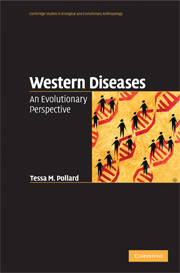Book contents
- Frontmatter
- Contents
- Preface
- 1 Introduction
- 2 An evolutionary history of human disease
- 3 Obesity, type 2 diabetes and cardiovascular disease
- 4 The thrifty genotype versus thrifty phenotype debate: efforts to explain between population variation in rates of type 2 diabetes and cardiovascular disease
- 5 Reproductive cancers
- 6 Reproductive function, breastfeeding and the menopause
- 7 Asthma and allergic disease
- 8 Depression and stress
- 9 Conclusion
- References
- Index
3 - Obesity, type 2 diabetes and cardiovascular disease
Published online by Cambridge University Press: 05 June 2012
- Frontmatter
- Contents
- Preface
- 1 Introduction
- 2 An evolutionary history of human disease
- 3 Obesity, type 2 diabetes and cardiovascular disease
- 4 The thrifty genotype versus thrifty phenotype debate: efforts to explain between population variation in rates of type 2 diabetes and cardiovascular disease
- 5 Reproductive cancers
- 6 Reproductive function, breastfeeding and the menopause
- 7 Asthma and allergic disease
- 8 Depression and stress
- 9 Conclusion
- References
- Index
Summary
Obesity is common and increasing in prevalence in Europe, North America, Australia and Latin America, particularly among the young (Seidell 1995; Martorell et al. 1998; Midthjell et al. 1999; Catanese et al. 2001; Tremblay et al. 2002; Thorburn 2005). While obesity emerged first in western populations, it is rapidly spreading to poorer countries (Yoon et al. 2006). Considerable concern has been expressed in the medical literature, as well as more widely, about the obesity ‘epidemic’ and its associated health consequences. In this chapter I outline the evolutionary context for the emergence of obesity as a major health problem, comparing what we know about diet and energy expenditure, the main determinants of obesity levels, in hunter–gatherer societies and in industrialised countries today. I also examine the closely related diseases type 2 diabetes and cardiovascular disease. Some populations seem to be particularly vulnerable to the development of obesity and related diseases, an issue explored in Chapter 4.
Diet, physical activity and body composition in humans before agriculture
The first members of the taxonomic group to which apes and humans belong (hominoids) lived 30 million years ago and subsisted largely on fruit, with some vegetable foods and meat. Meat began to assume more importance in the hominin line from around 7 million years ago, particularly with the advent of stone tools about 2 million years ago (Richards 2002).
- Type
- Chapter
- Information
- Western DiseasesAn Evolutionary Perspective, pp. 23 - 49Publisher: Cambridge University PressPrint publication year: 2008



